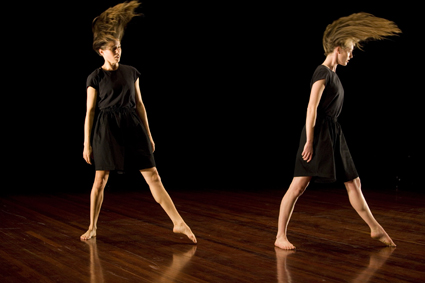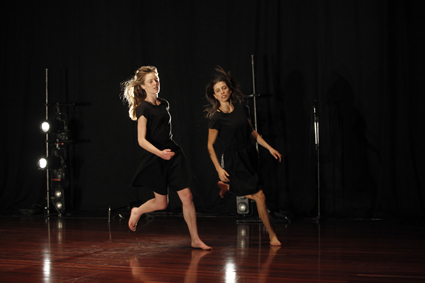unsettling the audience
varia karipoff: natalie abbott, physical fractals

Natalie Abbott, Sarah Aitken, Physical Fractals
photo Ponch Hawkes
Natalie Abbott, Sarah Aitken, Physical Fractals
IN NATALIE ABBOTT AND REBECCA JENSEN’S PHYSICAL FRACTALS, TIME BECOMES ELASTIC, STRETCHING ITS LIMITS TO CREATE PHYSICALLY PALPABLE TENSION.
At these apex moments in the performance, movement is paused and, when resumed, time seems to snap back to familiar shape. The performance, shared with Sarah Aiken, messes with our personal sense of gravity and our concept of space. Much of the time we are hyper conscious of our own breath, which is often bated.
Physical Fractals begins with the dancers’ repeated movements bordering on the obsessive and becoming increasingly laboured. The unison of Abbott and Aiken’s movement is made even more impressive by their physical uniformity, down to the length of their hair, their similar height and build. The movements soon create a familiar pattern for the audience; we anticipate a backstroke into the centre from the corner of the performance space that will give way to a circular motion, heads bent and hair twirling. Despite the similarity of the dancers we pick up the tiniest variations in their actions; how one holds her arm out behind her slightly higher than the other for instance. Abbott appears to attack the choreography with more sanguinity, her face set in determination. Aiken’s performance presence is more serene, or resigned—she mirrors Abbott beautifully.
The dancing is accompanied by heavy silence which gives way to looped sounds picked up live from the stage. The dancers’ unison becomes intermittent. The space falls into darkness as the sounds crescendo and grow more insistent. Wave after turbulent sound wave crashes over us, rendering us breathless and uncomfortable. It’s a wild sound, like wind and water filling your head. The sound (Daniel Arnot) works in conjunction with clever lighting (Govin Ruben); both disorient our visual sense and lead to small sensory glitches. Later, Abbott and Aiken swing microphones on long cords through the air. Our proximity to the performers makes this a shared sensation, dangerous and hypnotic. Darkness falls over them while the rushing sound of the swinging microphones continues. When the stage is re-lit, the dancers are on the floor when we expect them to still be swinging the microphones. We had sat knotted up and tense, trying to gauge something in the dark while imagining the microphones slipping out of control.

Sarah Aitken, Natalie Abbott, Physical Fractals
photo Ponch Hawkes
Sarah Aitken, Natalie Abbott, Physical Fractals
The success of the performance relies on tension and release—the pendulum swings from the dancers being the focus to the audience’s reaction taking centre stage. The next chapter of the dance is characterised by trotting feet, a kind of dance/march that eventually becomes plodding. The continued unison here made me think of Lipizzaner stallions—perhaps because the performers were now subserviently on all fours. The dance becomes more gruelling when the pair repeatedly collide with the floor, first backwards then straight back up and crumpling forward. The backfall is broken by one hand.
The audience watches on, unsettled and contemplative, again the focus on us—on our watching. The sensitive microphones around the space make us reluctant to move; I spot a woman guiltily swig from a beer bottle as the dancers fall again and again. Physical Fractals is an acutely rendered study in the boundaries between audience and performers. Here these boundaries are traversed through short-winded sensory experiences and in our emotional investment in the work.






